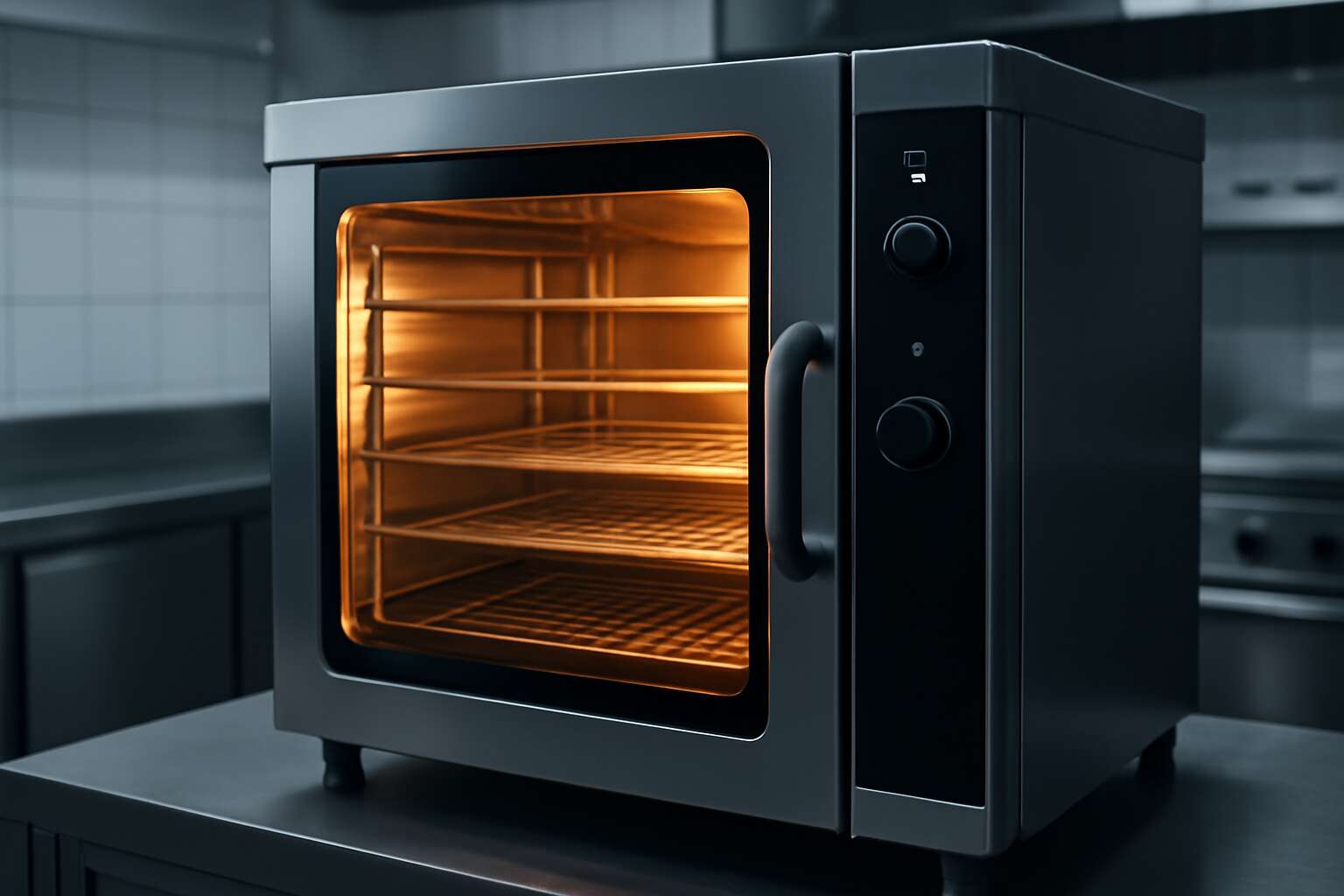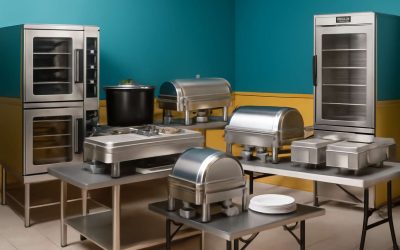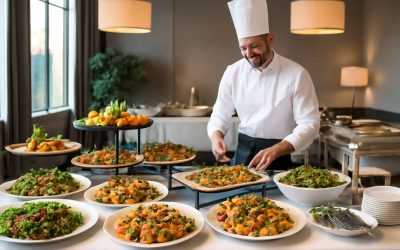Understanding Catering Ovens
Types of Catering Ovens – Array
In the shadowed halls of culinary mastery, the catering oven stands as both a guardian and a harbinger of flavour. Its form and function are as varied as the dishes it conjures from the depths of heat and steam. From the relentless convection ovens that whirl with ghostly precision to the venerable deck ovens, each type whispers its own tale of gastronomic prowess.
Understanding the different types of catering ovens is essential for those who dare to command the culinary dark arts. Some caterers prefer the flexibility of combi ovens, where steam and heat dance in harmony, while others rely on the simplicity of traditional pizza ovens, perfect for creating molten, charred perfection.
- Convection ovens — swift and efficient, ideal for roasting and baking in large quantities.
- Deck ovens — sturdy and reliable, perfect for bread and pizza with a crust that whispers of fire.
- Combi ovens — versatile, blending steam and dry heat to unlock textures unseen elsewhere.
Each catering oven type offers a different pathway through the culinary labyrinth, where mastery is forged in heat and shadow. The choice of oven becomes an extension of the chef’s dark artistry, shaping the very soul of their creations.
Key Features to Consider – Array
When selecting the perfect catering oven, understanding its key features can transform a good kitchen into a culinary sanctuary. A catering oven isn’t just about size or power; it’s about how it breathes life into your dishes—bringing consistency, efficiency, and innovation to your kitchen. Did you know that the right oven can cut cooking times by up to 30%, freeing valuable time for creativity and presentation?
One of the most vital aspects is temperature control. Precise, even heat distribution ensures every dish emerges with perfection—be it a crusty loaf or a succulent roast. Additionally, energy efficiency plays a crucial role, especially in busy catering environments where operational costs add up. Modern catering ovens often feature programmable settings, allowing chefs to fine-tune each cooking cycle with ease, turning culinary artistry into a seamless dance of heat and timing.
For those seeking versatility, a catering oven with multiple functions—such as convection, steaming, or infrared baking—can be a game-changer.
- Durability and build quality
- Ease of cleaning and maintenance
- Size and capacity to suit your establishment’s needs
These features collectively determine how well an oven integrates into your workflow, elevating your culinary dark arts from mere cooking to a craft of shadows and flames. With the right catering oven, mastery over flavour and texture becomes an enchanting reality.
Materials and Durability – Array
In the realm of culinary mastery, the materials and durability of a catering oven are the unseen warriors that uphold the art of cooking under relentless pressure. An expertly crafted catering oven is not merely a vessel for heat; it is a fortress built to withstand the rigours of a bustling kitchen. The choice of materials—stainless steel, cast iron, or specialised heat-resistant alloys—dictates not only longevity but also how efficiently heat is transferred, ensuring your dishes are cooked evenly and without interruption.
Stainless steel, renowned for its corrosion resistance and ease of cleaning, remains a favourite among professional kitchens. Its resilience means that even after countless service cycles, the oven retains its integrity, standing firm against the onslaught of spills and high temperatures. Conversely, cast iron components, when incorporated, provide exceptional heat retention, delivering a steady, even warmth that elevates your cooking precision.
When selecting a catering oven, consider the build quality as a vital factor—well-constructed models with reinforced panels and robust hinges can last for decades, becoming an indispensable part of your culinary ensemble. For example, a catering oven with a solid door latch and sturdy interior racks ensures smooth operation during the busiest of service hours, reducing downtime and maintenance woes. After all, durability isn’t just about longevity; it’s about consistent performance in the heat of the moment.
Benefits of Using a Catering Oven
Efficiency and Speed – Array
Efficiency and speed are the cornerstones of a high-performance catering oven. In busy kitchens, where every second counts, a quality catering oven can transform the workflow. It delivers consistent heat distribution, ensuring that dishes are cooked evenly without the need for constant supervision. This not only saves time but also reduces waste, as food is less likely to be overcooked or undercooked.
Moreover, a catering oven with advanced features—such as rapid preheat functions and multiple rack capacities—can handle large volumes with ease. This means more meals prepared in less time, satisfying demanding event schedules and tight deadlines. For those aiming to optimise productivity, investing in the right catering oven is a game-changer. It’s about working smarter, not harder, and keeping up with the fast pace of professional catering.
To maximise efficiency, consider a catering oven with the following capabilities:
- Fast heat-up times
- Multiple rack positions for simultaneous cooking
- Programmable settings for consistency across batches
Consistency in Food Quality – Array
In the bustling world of professional catering, consistency isn’t just a nicety—it’s a necessity. A top-tier catering oven ensures that every dish emerges with uniform perfection, no matter how many batches are prepared or how busy the service gets. This reliability means chefs can focus on creativity and presentation, confident that each plate will meet the same high standard. When food quality remains steady, it elevates the reputation of your establishment and delights discerning guests time and time again.
Thanks to advanced heat distribution and programmable settings, a catering oven guarantees that heat reaches every corner, eliminating those dreaded hot and cold spots. The result? dishes that are evenly cooked, tender, and bursting with flavour. This level of precision transforms culinary chaos into a symphony of consistency, even during the most demanding service periods. For those who thrive on excellence, investing in a reliable catering oven is akin to possessing a secret ingredient that consistently elevates the final outcome.
Versatility in Cooking Methods – Array
In the realm of professional catering, the ability to adapt and innovate in the kitchen is paramount. A versatile catering oven unlocks a world of culinary possibilities, allowing chefs to master a spectrum of cooking methods with a single, reliable piece of equipment. From roasting succulent meats to baking delicate pastries, the catering oven is the silent hero behind many a memorable feast.
What sets a top-tier catering oven apart is its capacity to handle multiple cooking techniques seamlessly. Whether you’re grilling, baking, steaming, or slow-roasting, this appliance adapts to your needs, offering unparalleled flexibility. Some models come equipped with specialised features such as convection, combi, or steam functions, enabling a chef to switch effortlessly between methods without switching appliances. This adaptability ensures that every dish is cooked to perfection, elevating your culinary repertoire and impressing even the most discerning guests.
Imagine a catering oven that can switch from a high-temperature roast to a gentle proofing cycle in moments—saving time and space in a bustling kitchen. The ability to perform diverse cooking tasks within a single unit not only streamlines operations but also inspires creativity. For catering professionals, it’s like having a culinary chameleon at your fingertips, turning any challenge into an opportunity for innovation and excellence.
Enhanced Service Experience – Array
In the bustling world of professional catering, delivering an impeccable service hinges on more than just culinary skill—it relies heavily on reliable, efficient equipment. A state-of-the-art catering oven becomes the unsung hero, elevating the guest experience to a realm of memorable excellence. When utilised to its full potential, this versatile appliance transforms ordinary kitchens into centres of culinary innovation, delighting guests with perfectly cooked dishes every time.
One of the most compelling benefits of employing a catering oven is the ability to enhance service speed and flexibility. It allows catering teams to prepare multiple dishes simultaneously, maintaining high standards without sacrificing time. This efficiency not only reduces wait times but also ensures that each plate leaving the kitchen is an exemplar of quality and precision. Furthermore, a catering oven’s capacity to handle diverse cooking techniques means chefs can adapt swiftly to changing demands, creating a seamless dining experience that impresses even the most discerning guests.
Imagine a catering oven that can transition effortlessly from baking delicate pastries to roasting hearty meats—this level of adaptability not only streamlines operations but also fosters culinary creativity. With features such as convection, steam, or combined functions, this single piece of equipment becomes a true culinary chameleon. It’s an essential asset in delivering an elevated service experience, transforming ordinary events into extraordinary feasts filled with flavour and finesse.
Choosing the Right Catering Oven
Assessing Your Business Needs – Array
Choosing the right catering oven is a pivotal decision that can elevate your culinary service to new heights. It’s not merely about capacity or size; it’s about aligning the oven’s capabilities with your specific business needs. A catering oven that’s too small may hinder your ability to serve large parties efficiently, while an oversized model could waste energy and space in your kitchen.
Assessing your business needs involves understanding your typical volume of orders, menu complexity, and the variety of dishes you prepare. For instance, a bustling event catering company might prioritise a catering oven with rapid heat-up times and high throughput. Conversely, a boutique catering service may value versatility and precise temperature control.
To make an informed choice, consider these factors:
- The frequency and scale of catering events
- The variety of menu items requiring different cooking methods
- Energy consumption and operational costs
Matching these elements with the right catering oven ensures efficiency, consistency, and customer satisfaction—core ingredients for a thriving catering enterprise.
Budget Considerations – Array
In the realm of professional catering, the investment in a catering oven transcends mere equipment—it becomes an extension of your culinary vision. Budget considerations are not simply about initial expenditure but about weighing the long-term operational costs and the tangible return on investment. A meticulously chosen catering oven, aligned with your financial parameters, can unlock efficiencies that reverberate through every event you service.
While it’s tempting to opt for the most affordable model, it’s crucial to recognise that a high-quality catering oven, though initially more costly, often yields savings through energy efficiency and durability. For those operating within strict budget constraints, prioritising features such as energy consumption and maintenance costs can make all the difference. Remember, a catering oven’s true value lies in its ability to seamlessly integrate with your workflow and elevate your service standards.
To navigate this intricate balance, consider these factors:
- The total cost of ownership, including energy bills and upkeep
- The scalability of the catering oven relative to your growth plans
- The potential for customisation to meet specialised menu demands
By weaving these elements into your purchasing strategy, you ensure your catering oven becomes a cornerstone of efficiency and excellence—an investment that pays dividends in client satisfaction and operational mastery.
Additional Features for Optimal Performance – Array
Choosing the right catering oven involves more than just selecting the basic model; additional features can significantly enhance performance and efficiency. For instance, integrated steam functions can improve food moisture and texture, ensuring dishes come out perfectly every time. Precise temperature controls are essential for maintaining consistency, especially when preparing a diverse menu.
Consider features like programmable settings, which streamline operation during busy events, or advanced ventilation systems that prevent overheating and maintain a safe working environment. Some catering ovens also offer modular designs, allowing you to customise the setup based on your specific needs.
When evaluating these features, remember that an investment in a catering oven with reliable, additional capabilities often translates into smoother workflow and higher quality output. After all, the right combination of features can turn a good catering oven into a true workhorse — elevating your service standards and keeping your operation ahead of the competition.
Popular Brands and Models – Array
Choosing the right catering oven is a decisive step that can transform your culinary operations. When navigating the market, it’s crucial to focus on popular brands and models renowned for their reliability and innovation. Brands like Rational, Garland, and Convotherm consistently deliver high-performance catering ovens that stand the test of time.
Many professional kitchens swear by Rational’s multi-functional ovens, which combine precise temperature controls with versatile cooking modes. Garland’s durable, heavy-duty catering ovens are celebrated for their robustness in demanding environments, while Convotherm offers models with integrated steam functions that ensure perfect moisture retention.
- Rational
- Garland
- Convotherm
Evaluating these brands involves examining customer reviews, warranty offerings, and after-sales service — elements that often reveal a brand’s true calibre. Remember, choosing a catering oven from a trusted manufacturer can mean the difference between a consistent, high-quality output and constant operational hiccups. The right model not only elevates your kitchen’s performance but also provides peace of mind, knowing your investment is built to endure.
Maintaining and Cleaning Catering Ovens
Routine Maintenance Tips – Array
A well-maintained catering oven is the unsung hero of any bustling kitchen, quietly ensuring that every dish reaches perfection. Routine cleaning and maintenance not only prolong the lifespan of this culinary workhorse but also optimise its efficiency, saving precious time and energy during those hectic service hours. Interestingly, neglecting proper care can lead to uneven cooking, compromised food safety, and unnecessary repair costs—a scenario best avoided.
To keep your catering oven in pristine condition, consider incorporating a few simple yet effective practices. Regularly removing grease and food debris, inspecting heating elements, and checking door seals can make a significant difference. For example, a quick weekly wipe-down with non-abrasive cleaners can prevent the build-up of stubborn grime, which otherwise diminishes heat retention.
- Ensure the oven is unplugged before cleaning.
- Use specialised oven cleaning agents suited for catering ovens.
- Pay extra attention to door seals and vents to prevent heat loss.
By adopting these routine maintenance tips, your catering oven remains an unwavering pillar of culinary excellence, ready to serve up a flawless performance day after day.
Cleaning Procedures – Array
Maintaining a catering oven is more than just routine cleaning; it is a ritual that safeguards the soul of your kitchen. An impeccably clean catering oven not only sustains its efficiency but also preserves the integrity of every dish it helps create. The importance of a thorough cleaning procedure cannot be overstated—every crumb and grease splatter is a silent thief of heat and flavour.
When embarking on the cleaning journey, always remember to unplug the catering oven to avoid accidents. Use specialised oven cleaning agents for a gentle yet effective cleanse, ensuring that delicate components like door seals and vents are scrutinised with care. These parts are vital for heat retention and energy efficiency, and neglecting them can lead to uneven cooking or increased energy consumption.
To streamline your cleaning routine, consider following this simple order:
- Remove loose debris and food residues after each service.
- Apply the cleaning agent and allow it to work for a few minutes.
- Use a non-abrasive scrubber to gently remove grime, paying special attention to door seals and vents.
- Wipe down with a damp cloth and dry thoroughly before plugging the oven back in.
Deep cleaning at regular intervals not only prolongs the lifespan of the catering oven but also ensures that it operates at peak performance—ready to face the relentless demands of a busy kitchen. Every element, from the heating elements to the interior lining, benefits from this meticulous care, transforming maintenance from a chore into a moral obligation for culinary excellence.
Troubleshooting Common Issues – Array
Within the relentless rhythm of a busy kitchen, even the most robust catering oven can encounter unexpected obstacles. Troubleshooting common issues is not just about fixing a malfunction; it’s about safeguarding the heartbeat of your culinary enterprise. When a catering oven refuses to heat or cooks unevenly, it’s as if the soul of your kitchen stutters, reminding us that maintenance is an ongoing moral obligation, not merely a task.
Understanding the root of these problems often reveals deeper truths about the importance of diligent upkeep. For instance, faulty temperature regulation might stem from a malfunctioning thermostat, or perhaps a build-up of grease and debris is interfering with heating elements. Regular inspection and cleaning of vital components can prevent such issues from spiralling into costly repairs.
- Check the power supply and circuit breaker—sometimes, the simplest solutions are overlooked.
- Inspect door seals and vents for damage or blockages—these are critical for energy efficiency and even cooking.
- Test the heating elements—if they are charred or broken, replacement may be necessary.
Moreover, persistent problems such as inconsistent heat or erratic controls might hint at deeper electrical faults or sensor failures. These require a nuanced approach—sometimes a professional consultation becomes an unavoidable part of the journey, reaffirming that caring for a catering oven embodies a continuous moral commitment to excellence.
Integrating Catering Ovens into Commercial Kitchen Setup
Optimal Placement and Space Planning – Array
In the intricate dance of a bustling commercial kitchen, the placement of a catering oven can mean the difference between harmonious operation and chaos. A well-integrated catering oven becomes the heartbeat of culinary artistry, its strategic position echoing the rhythm of efficient service. When planning your space, consider the flow—the natural movement of staff and ingredients—so each catering oven is accessible yet unobtrusive, a silent partner in culinary creation.
Optimal placement isn’t merely about proximity; it’s about harmony with other vital equipment. For instance, positioning the catering oven near prep stations and refrigeration units reduces unnecessary movement, fostering a seamless workflow. Space planning should also account for ventilation and safety, ensuring the catering oven breathes freely without hindering other operations.
- Ensure enough clearance for easy access
- Prioritise proximity to service counters
- Maintain clear pathways for staff movement
Meticulous planning transforms a crowded kitchen into an orchestrated space where each element supports the culinary symphony, elevating both efficiency and the overall service experience.
Complementary Equipment – Array
Integrating a catering oven seamlessly into your commercial kitchen demands more than just a keen eye for aesthetics; it requires strategic harmony with existing equipment. When planning your setup, consider how the catering oven complements essential appliances such as convection ovens, warming drawers, and refrigeration units. A well-thought-out integration ensures that each component supports the other, enabling a fluid culinary operation that mimics a well-rehearsed ballet.
To maximise efficiency, many kitchens benefit from arranging their catering oven in proximity to prep stations and service counters. This proximity reduces unnecessary movement, saving precious seconds during busy service hours. Additionally, ensuring the catering oven is positioned in a way that allows easy access for both staff and maintenance personnel can prolong its lifespan and optimise performance. Remember, a catering oven isn’t just about cooking; it’s about creating a symphony of appliances that work in unison to elevate your culinary output.
Safety Considerations – Array
Integrating a catering oven into your commercial kitchen isn’t merely about placement; it’s about safeguarding your team and the integrity of your culinary craft. Safety considerations must be woven into the fabric of your setup, ensuring that every element aligns with rigorous standards. The stakes are high—hot surfaces, electrical connections, and airflow pathways demand meticulous attention.
To mitigate risks, consider implementing a systematic approach for the installation process. This includes securing proper ventilation, grounding electrical components, and creating designated zones for high-heat appliances. An effective way to streamline this process is by adopting a logical sequence, such as:
- Assessing the proximity of the catering oven to power sources and exhaust systems.
- Ensuring sufficient clearance around the appliance to prevent accidental contact or fire hazards.
- Designing a layout that facilitates easy access for both staff and maintenance personnel, reducing the risk of mishandling or injury.
Remember, safety is not an afterthought but a foundational element that underpins operational excellence. A well-integrated catering oven, positioned with care and foresight, becomes a vital asset—supporting your team while upholding the highest standards of safety and efficiency in your commercial kitchen.
Latest Trends and Innovations in Catering Ovens
Smart Technology Integration – Array
In an era where culinary innovation is as vital as the ingredients themselves, the latest trends in catering oven technology are nothing short of revolutionary. Smart technology integration has transformed these appliances from mere heat sources into sophisticated culinary assistants. Imagine a catering oven that not only monitors its internal temperature but also adjusts its settings automatically, ensuring perfect results every time.
One of the most captivating innovations is the advent of IoT-enabled catering ovens. These ovens allow chefs to control and monitor cooking processes remotely, whether from a tablet or smartphone. Such connectivity streamlines kitchen operations and elevates efficiency, especially during busy service hours. Additionally, features like voice command compatibility and intelligent diagnostics are becoming standard, making maintenance and troubleshooting a breeze.
As catering ovens continue to evolve, embracing these modern advancements can significantly enhance workflow and food quality, setting a new standard for professional kitchens.
Eco-Friendly and Energy-Saving Features – Array
As sustainability becomes a non-negotiable in the hospitality industry, the latest trends in catering oven technology are leaning heavily towards eco-friendly and energy-saving features. Modern catering ovens now incorporate advanced insulation and smart temperature controls that significantly reduce energy consumption without sacrificing performance.
Many models are designed with environmentally conscious materials and include energy-efficient modes that optimise power use during off-peak hours. These innovations not only help reduce carbon footprints but also lead to noticeable savings on energy bills—a win-win for busy kitchens seeking cost-effective solutions. Additionally, some catering ovens come equipped with features like automatic shut-off and standby modes, further enhancing their eco-profile.
For those prioritising sustainability, choosing a catering oven with energy-saving features can make a tangible difference. Not only does it demonstrate a commitment to environmental responsibility, but it also aligns with the growing consumer demand for eco-conscious dining experiences. In a competitive market, integrating these modern innovations can set a catering operation apart while supporting broader environmental goals.
Customization and Modular Designs – Array
In a culinary landscape where innovation is the heartbeat of progress, the latest trends in catering ovens reveal a fascinating shift towards unparalleled customization and modular design. These advancements empower chefs and restaurateurs alike to craft a cooking environment tailored precisely to their unique needs, elevating both efficiency and artistry. The allure lies in the flexibility—whether adjusting the size, configuration, or specialized features—catering ovens now transcend traditional boundaries, offering bespoke solutions that adapt seamlessly to diverse culinary demands.
Modular catering ovens exemplify this evolution, allowing for scalable setups that grow with your business. They can be expanded or reconfigured with ease, ensuring longevity and adaptability amidst changing menus or service styles. This modular approach not only optimises space but also simplifies maintenance and upgrades, preserving the investment and operational harmony.
The modern catering oven market increasingly integrates intuitive controls and customisable cooking modes, turning an appliance into a versatile culinary partner. From specialised baking chambers to multi-purpose units, the emphasis on tailored functionality reflects a broader trend towards personalised kitchen equipment. Such innovation ensures that a catering oven doesn’t just cook—it transforms the entire culinary experience, making it more dynamic and responsive to the chef’s vision.
In essence, the convergence of customisation and modular design heralds a new era in catering oven technology—one where adaptability meets sophistication, and each kitchen becomes a bespoke stage for gastronomic artistry.




0 Comments